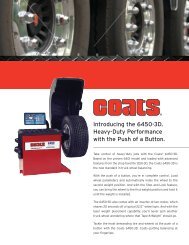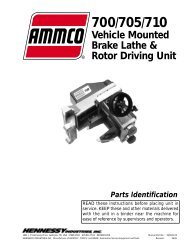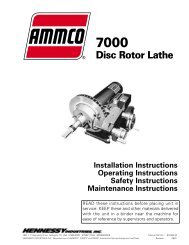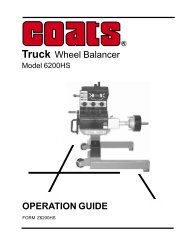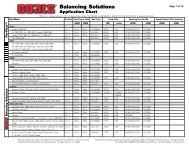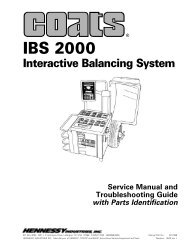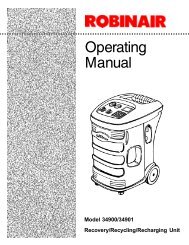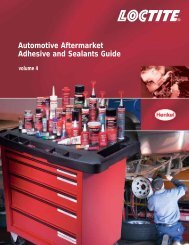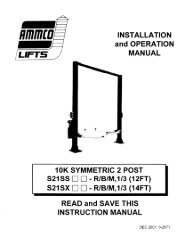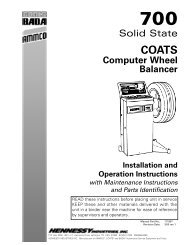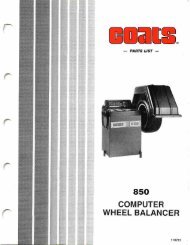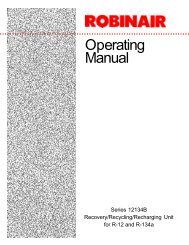Robinair 75650 Coolant Recycler - NY Tech Supply
Robinair 75650 Coolant Recycler - NY Tech Supply
Robinair 75650 Coolant Recycler - NY Tech Supply
Create successful ePaper yourself
Turn your PDF publications into a flip-book with our unique Google optimized e-Paper software.
Checking<br />
For Leaks<br />
20<br />
You can check a cooling system for leaks<br />
using the built-in pressure testing<br />
function prior to servicing or after. If the<br />
system holds a pressure level, you know<br />
it is leak-free and you can refill it with<br />
coolant. However, if it doesn’t hold a<br />
pressure level, you know there is a leak<br />
that must be repaired.<br />
Be sure the New <strong>Coolant</strong> tank has the<br />
amount of antifreeze/coolant needed for<br />
the vehicle being serviced by checking<br />
the sight glass on the front of the unit.<br />
Also, check the manufacturer’s specifications<br />
for engine coolant capacity. Use a<br />
50/50 mix of new antifreeze and water or<br />
recycled coolant which has been adjusted<br />
to a 50/50/ mix.<br />
WARNING!<br />
Handle battery connection cables with<br />
extreme caution — batteries generate<br />
explosive gases during normal battery<br />
operation. Working in the vicinity of a<br />
lead-acid or other automotive battery is<br />
dangerous. Wear complete eye protection.<br />
NEVER smoke or allow a spark or<br />
flame in the vicinity of a battery.<br />
1. First, connect the red power lead to<br />
the “+” (positive) post of the vehicle<br />
battery or to another 12V power<br />
source. Then connect the black power<br />
lead to an engine ground, not the<br />
battery “-” terminal.<br />
WARNING!<br />
The radiator may contain hot coolant.<br />
Wear eye and hand protection.<br />
2. Slowly remove the vehicle’s radiator<br />
cap, connect and tighten the appropriate<br />
radiator cap adapter, then<br />
connect the <strong>Coolant</strong> Outlet hose<br />
(with clear window) to the radiator<br />
cap adapter.<br />
3. Turn the upper control panel valve to<br />
DRAIN AND FILL and the lower<br />
control panel valve to NEW COOL-<br />
ANT. Set the control panel switch to<br />
ON.<br />
<strong>75650</strong> AF Pro Plus <strong>Coolant</strong> <strong>Recycler</strong> 4. Open the valve on the <strong>Coolant</strong> Outlet<br />
hose (with clear window). The pump<br />
will pressurize the system to about 7<br />
psi.<br />
5. Watch the pressure gauge for any<br />
pressure loss. The system should<br />
hold a constant pressure; the pump<br />
will try to maintain the pressure at 7<br />
psi (48 kPa, 0.5 bar). If there is a loss<br />
of pressure, check for system leaks. If<br />
a leak is noted, set the control panel<br />
switch to OFF. Then turn the valve<br />
on the <strong>Coolant</strong> Outlet hose (w/clear<br />
window) to OFF and repair the leak.<br />
If necessary, drain the coolant before<br />
making repairs.<br />
6. Repeat Steps 3 and 4 until no loss of<br />
pressure and no leaks are indicated.<br />
If you drained the system before<br />
making repairs, refill using vacuum<br />
assist (refer to Refilling Using<br />
Vacuum Assist section on page 15).<br />
Repeat this entire procedure.<br />
7. To end the pressure test, set the<br />
control panel switch to OFF. Close<br />
the valve on the <strong>Coolant</strong> Outlet hose<br />
(with clear window). Disconnect the<br />
<strong>Coolant</strong> Outlet hose from the radiator<br />
cap adapter.<br />
WARNING!<br />
The system is under pressure. Be sure<br />
to remove the radiator cap adapter very<br />
slowly in the next step.<br />
8. To relieve pressure, connect the<br />
<strong>Coolant</strong> Inlet hose (solid black) to the<br />
radiator cap adapter. Slowly remove<br />
the radiator cap adapter. Replace the<br />
vehicle’s radiator cap.<br />
9. Disconnect the black power lead,<br />
then disconnect the red power lead<br />
from the vehicle battery or 12V<br />
power source. Store the hoses and<br />
power leads on the side brackets.



